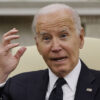What makes a midterm election different from a presidential election?
Midterm elections obviously differ from presidential elections as the president is not on the ballot, and has two years left in his term, but that’s not the only difference between them.
Here are five things to know about midterm elections.
1. Less Than Half The Country Will Vote
The Pew Research Center estimates that only 40 percent of eligible voters will cast a ballot in the 2014 midterm elections. Presidential election turnout is typically higher. For example, turnout in 2008 was 62.3 percent, and 57.5 percent in 2012, according to the Bipartisan Policy Center.
2. Midterm Voters Are More Partisan
According to Pew, nonvoters in midterm elections have “low levels of political engagement” and a party’s “core supporters” are “more likely to vote.”
According to Pew, 47 percent of nonvoters identify with neither party, and 68 percent of likely voters do identify with one of the parties.
3. The President’s Party Is Often in for a ‘Shellacking’
The president’s party historically loses seats in Congress during midterm elections.
In fact, according to T.A. Frail at Smithsoinian.com, only two presidents saw their own party gain seats during their first midterm – Presidents Franklin Delano Roosevelt and George W. Bush.
Frail describes a series of the president’s party suffering defeat after a midterm, calling them “pivotal moments” in American history.
After the most recent midterm in 2010, President Barack Obama described his party’s loss as a “shellacking.”
4. Midterm Elections Are More Local
Larry Sabato, the director of the Center for Politics and a professor at the University of Virginia, told PBS that the idea that midterms take a “national temperature of public opinion” is a “myth.”
“This is always presented as a national election,” Sabato said. “It is actually an unrepresentative sampling of state elections.”
5. It’s Still Expensive
According to CNBC, the 2014 election will be the most expensive midterm in history.
The Center for Responsive Politics predicts that the 2014 midterm elections will cost $3.67 billion, even more than the $3.63 billion in 2010.
The Washington Post reports that the race between Sen. Kay Hagan, D-N.C., and her Republican opponent Thom Tillis in North Carolina might become the most expensive senate race in American history.





























